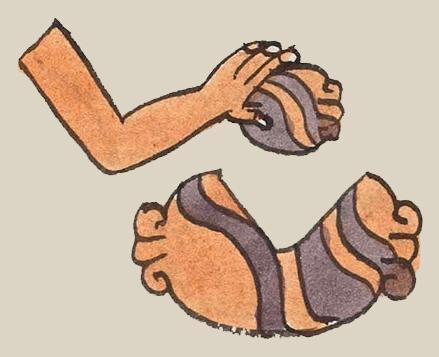tlapana (Mdz29r)
This compound glyph for the place name Tetlapanaloyan can also represent the action of splitting a stone (the verb, tlapana). An arm with a (left) hand holds a stone. Below that, we see a larger, oval, horizontal stone with a v-shaped piece missing along the top. Both stones have purple and terracotta-colored wavy stripes and curling elements at the ends that are so indicative of the stone glyph (tetl). A couple of examples of tetl have been provided, below right.
Stephanie Wood
Presumably, the person using the smaller stone to hit the larger stone has already broken a chunk out of the larger stone. That this is a verb is implied by the action indicated. It is also easy to isolate the verb in the middle of the place name (tlapana) after taking off the Te- (impersonal, and further phonetically represented by the stone, tetl). The -lo- is also impersonal, noting that rocks are broken without specifying anyone and the -yan locative suffix that typically attaches to a verb, explaining that this action is customary, as Frances Karttunen explains. [Frances Karttunen, unpublished manuscript, used here with her permission.] So, the result is that this is a place where rocks were probably quarried and shaped or crushed.
Stephanie Wood
c. 1541, but by 1553 at the latest
Stephanie Wood
stones, rocks, splitting, breaking, rocas, piedras, quebrar

tlapana, to break or split something open, https://nahuatl.wired-humanities.org/content/tlapana-0
ma(itl), hand or arm, https://nahuatl.wired-humanities.org/content/maitl
Codex Mendoza, folio 29 recto, https://digital.bodleian.ox.ac.uk/objects/2fea788e-2aa2-4f08-b6d9-648c00..., image 68 of 188.
Original manuscript is held by the Bodleian Libraries, University of Oxford, MS. Arch. Selden. A. 1; used here with the UK Creative Commons, “Attribution-NonCommercial-ShareAlike 3.0 License” (CC-BY-NC-SA 3.0)


